
Rasa
Lila
The Ras Lila, the
epitome of Manipuri classical dance is inter-woven through the celestial
and eternal love of Radha and Krishna as has been described in
the Hindu scriptures
and reveals the sublime and transcendental love of Krishna and Radha...
It is said
that when Krishna, Radha and the Gopies danced the Ras Leela, Shiva
made sure that no one disturbed the beauty of the dancing. Parvati,
the consort of Lord Shiva also wished to see this dance, so to please her,
he chose the beautiful area of Manipur and re-enacted the Ras Leela.
Maharaja Bhagya Chandra Singha - King of Manipur introduced the "Manipuri
Maha Rasleela " in the Manipur valley during his reign. It
ushered in a new era in the development of this style. The Ras Lila, the
epitome of Manipuri classical dance is inter-woven through the celestial
and eternal love of Radha
The
Ras Lila is the most important dance form in the Manipuri
style. The theme revolves around the love of Krishna and the
milkmaids (gopinis)
|
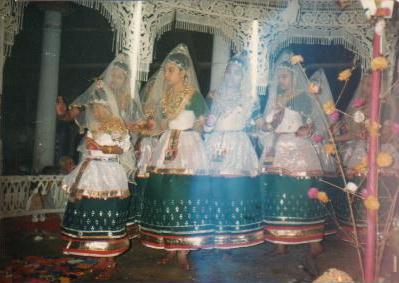
|
and Krishna as
has been described in the Hindu scriptures and reveals the sublime
and transcendental love of Krishna and Radha and the Gopies 's devotion to
the Lord. It is generally performed in an enclosure in front of the temple
throughout the night and watched with a deep sense of devotion.
The
Rasleela in the Manipuri dance can be further divided into four types:
-
Vasanta
Rasa: Performed in Purnima Tithi in the month of Falgun
& Chaitra based on GovindaliLamrita.
-
Kunja
Rasa: Performed in Purnima Tithi in the month of Baishakh
based on BrahmaBaibarta Purana.
-
Maha
Rasa: Performed in Purnima Tithi in the month of Kartika based
on Shrimod VhagobotGita ponchadhaya.
-
Nitya
Rasa: Performed in any day in any month of year based on
GovindaliLamrita.
While
there is ‘bhava’ (emotion) of Radha’s surrender to Krishna, in some,
the other’s have the theme of Radha-Krishna “Shrinagar”, and some
depict the “viyoga” (separation) of Krishna. These are the themes of
Gita Govinda GovindaliLamrita and other Varnava
literacy works. Typical
Rasleela includes the following steps -
-
Krishna
Abhisaar
-
Radha-Gupi
Abhisar
-
Arrangement
of Mondob
-
Rag-Alap
of Gupis
-
Achouba
Vongipareng
-
Krishna
Nartan
-
Radha
Nartan
-
Different
kind of Dances of the Gupis
Ras
performances are seasonal and varied and performed at the temple of Shree
Shree Govindajee in Imphal, ZuraMandhop at Moulvibazar , Bangladesh
, on the nights of Basanta Purnima, Sarada Purnima and Kartik Purnima and
at some other local temples in Some Bishnupriya Manipuri inhabited areas
in Bangladesh , Tripura and Assam.
More
Info:
http://manipuri.8m.com/

Rakhual
The "Rakhual"(
sometimes called as Gusthalila ) Dance is a group dance performed by
a group of boys, wearing colorful dresses and ornaments.. The theme of the
dance that is described in the Mahabharata where Lord Krishna dances with his
mates. Sri Krishna's game,
The
"Rakhual" Dance is a group dance performed by a
group of boys, wearing colorful dresses and ornaments
|
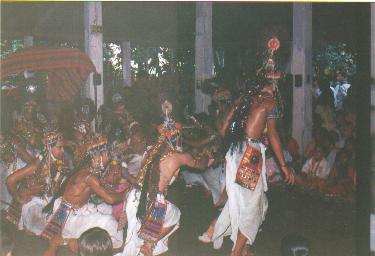
|
association
with the pastoral boys, Yosoda's love for her son, The coming of
sage Narada to the palace of Nanda and teaching Krishna and
Balaram how to milch and graze the cattle are invariably shown. Then the
Gopas go to tending cattle with the permission of their parents. When the
start playing , two demons come to kill Krishna and Balaram by the order
Of Kamsa. The Roles of Nanda, Yosoda, Rohini, Narada and his
disciples are performed by the elderly people. This form celebrates the Krishna story through dance that is
obviously derived from the older forms, but is more stylized, and altered
considerably by the wearing colorful dresses like Feichooms or Dhutis,
Churas, koknaams, leitrengs and khobols .This highly stylised form of
Dancing has sublimity, subtlety and grace.

Khubak
Ishei
During the month of Aashar The Manipuris observe Rath Jatra
(Drawing of car of Lord Jagannatha) on the model of Puri festival.
According to Manipuri tradition every temple in every place will observe
it with great supports of peoples who contributes their mite to its
success. It has a 9-day program of devotional music and dances
followed by the free distribution of Khichuri's, a dish made of
rice and beans.
Khubak Ishei and Jaya Deva are the gifts of Rath Jatra in
Manipuri culture. The significant events for the daily service during
the nine days, apart from the above are listening to sacred texts
explained by a specialist in the day , the recitation and singing of Dasa
Avtar Slaks and the performance of Khubak Ishei by the male
or female artists. Khubak Ishei is a type of Clapping song mainly
performed by the female singers with a male drummer. This form was
initiated during the reign of King Churachand Singha.They sing the song
of Radha's pang of separation after Krishna left her and the Gopis and
went to Mathura on a car to join Kamsa's Yanja.

Khamba
Thoibi
In the 15th century
AD, Khamba, a prince of the previously routed Khumal
Royal family ( probably a Bishnupriya ) fell in love with Thoibi - a
princess of the Moirang clan ( probably
a Meithei ). The union have been to the
political advantage of both Khumals and Moirangs...
Khamba-Thoibi
is duet dance which is performed either a part of Lai- Harouba or
independently. This dance typically represents the Tandava and Lsya
aspects of Laiharouba movements. In the Khamba -Thoibi tells the
story of Khamba, a poor brave lad of khumal clan who fell in love with
Thoibi, a princess of Morang.In 15th
century AD, Khamba, a prince of the previously routed Khumal Royal family
( probably a Bishnupriya ) fell in love with Thoibi - a princess of
the
Khamba
Thoibi dance is a duet of male and female partners, a dance of
dedication to the sylvan deity, Thangjing of Moirang , is the
depiction of the dance performed by Khamba and Thoibi, the hero
and heroine of the Moirang episode of the hoary past
|
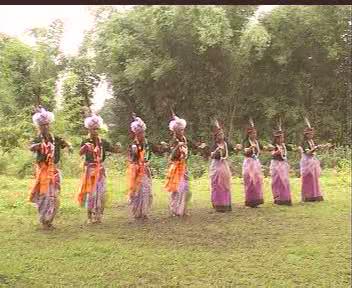
|
Moirang
clan ( probably a Meithei ).[Note 6] The union have been to the
political advantage of both Khumals and Moirangs ; but the moirang chief resisted on
purely personal grounds. The result was tragic not only for the young
lovers but also for the feuding tribes of Manipur. Khamba Thoibi dance is
a duet of male and female partners, a dance of dedication to the sylvan
deity, Thangjing of Moirang , is the depiction of the dance performed by
Khamba and Thoibi, the hero and heroine of the Moirang episode of the
hoary past.[Note 7] This, with the "Maibi"
dance (Priestess dance) , the "Leima Jogoi" etc. form the
"Laiharaoba" dance. This dance is
a part and parcel of Moirang Lai-Haraoba. It is believed that the legendary
hero - Khamba and heroin - Thoibi danced together before the Lord
Thangjing, a celebrated deity of Moirang, a village in the South-West of
Manipur which is known for its rich cultural traditions, for peace and
prosperity of the land.

Pala
Kirtana
Vaishnava Pala
Kirtana using Dhak and Kartal became most popular factor in Manipuri fine
arts. The dance is otherwise known as Kartal Cholom or Cymbal Dance is a
characteristic of the
Pala
Kirtana: the Pala Kirtana is a group performance of male partners,
using cymbals and wearing snow-white ball-shaped large
turbans
|
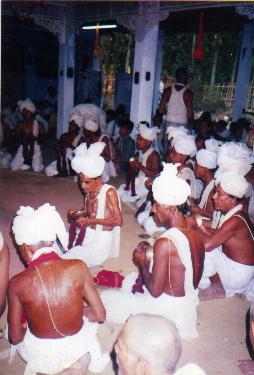
|
Manipuri style of dance and music. The initial movements
of this dance are soft and serene , gradually gathering momentum. It is a
group performance of male partners, using cymbals and wearing snow
white ball-shaped large turbans, who sing and dance to the accompaniment
of the ancient classical drum "Dhak".
Pala kirtan or Nata Sangkirtan is an invariable item for the life
cycle of manipuris and religious festivals. Nothing from birth to death is
complete without it. The pala's under two leaders i.e, Ishalpa
(main singer) and Duhar (leader of the choom part) with turbans and
Dhuties perform the kirtan. King Jaysingha is said to have
initiated the prsenet form of Pala Kirtan style.

Pung
Cholom
Pung Cholom ( also known as The Mridanga Dance or Dhumel or Dram dance),
is a combination of sound and movement, In 1850 AD, king Chandra Keerti
Singh added some compositions and
was instrumental in introducing 64 pung dance or drum dances...
Pung Cholom ( also known as The Mridanga Dance or Dhumel or Dram
dance), is a combination of sound and movement, the later in parts
demanding acrobatics abilities. The dancers themselves play the
Mridanga(Pung) while executing the performance. It is highly refined
classical dance number characterized by the modulation of sound from soft
whisper to
Pung
Cholom ( also known as The Mridanga Dance or Dhumel or Dram
dance), is a combination of sound and movement, the later in parts
demanding acrobatics abilities
|

|
a thunderous
climax. There is the interplay of intricate rhythms and cross rhythms with
varying markings of time from the slow to the quick with graceful and
vigorous body movements leading to ecastic heights.
It is performed either as an integral part of Nat sangkirtan (Pala
Kirtana) or independently. As a part of Pala, it performed by two players
but as an independent dance at least 14 players follow the sequence of
Pala Kirtana with about 40 complicated talas and Sanchars.
The rulers patronized and organized 4 distinct types in connection with
Hindu religious festivals.

Thabol
Chongba
The most beautiful and seductive dance of the
Manipuri Meitheis is Thabol Chongba. Thabol
Chongba literally means moon light jump. The youth of
the village flock together in hundreds...
The most beautiful and seductive dance of the Manipuri Meitheis is Thabol Chongba.
Thabol Chongba literally means moon light jump. The youth of the
village flock together in hundreds. As soon as the moon rises over the
hills the flute, the drums and the cymbals starts pouring out music.
The
boys and girls in a circle clutch each others hands with rhythms of music
slow and fast, high and low, up and down. If the number is great they may
form two or three rows so that everybody and anybody can participate in
the dance. Of its special interest in the dance of legs and of the mind by
the side of girl on the part of the males and also by the side of youth on
the part of the females and hand in hand dancing. They wear no make-up and
special costumes.
A main singer
or well trained artist with Horibola sings religious songs, historical
ballads, epics of moirang etc. The participants echoes his words in a
chorus. The Dholok beating supplied the tempo and rhythms of the dancers.
In the past the dance was concluded with song of Mikon Thangba wherein he
Pancha Bhoot with the shadow of the body was asked or made to reside in
the body just below the navel after a train of questions and soul's reply
to them.[Note 10]

Maibi
Dance
During
the
festival of Lai-Haraoba which is an annual ritual festival of the
Meitei Manipuris, the inhabitants of the valley of Manipur, the
Maibis, the
priestesses considered to be spiritual mediums, trace through
their dances
the whole
the
Maibis, the priestesses considered to be spiritual mediums, trace
through their dances the whole concept of cosmogony of the Meitei
people...
|
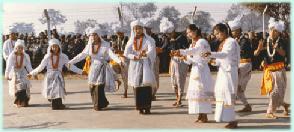
|
concept
of
cosmogony of the Meitei people and describe their way of life.
Beginning with the process of creation, they show the construction of
houses and
various occupations of the people to sustain themselves. It is a
kind of
re-living of the way of life of the past. The Maibi holds such
items as
breath-taking ceremony of the God on the bank of a river ,
summoning its
spirit in an earthen pot through nine threads and seven threads
for God
and Goddesses, dance of the Maibis holding the leaves of sacred
plant
called Langthrei between fingers.

Ballet
and Drama
Ballet or
dance drama is also a colorful part of Manipuri Culture. It is theatre and
Jatra that have the honor of being the cheif cultural and artistic forms
during the past few decades. Maharaj Churachand Singha, true to manipuri
tradition of patronising the art forms helped with men and money during
his reign.the contemporary Manipuri theatre is a continuation of the
earlier tradition. Phagi Lila's , introduced by comedians are drwan
from their appearance and mode of inacting.There are dance
dramas like Nimai-Sonyas, Sita-Horon, Nouka-Bilash,Savitri-Styaban,
Chandrajini, Harishchandra, Nal Domoyonti, Moirang Parva,
Ramayana,Kurukhetra, Lankakanda, Kamsabadha, etc. which are wonderful
and beautiful.
The jatra is like an opera
generally performed in the open in a circle surrounded by audiences, stage or
screen. The famous ballet Numit speaks the story of two suns, having
rhythm, expression and lyric.
Other
Devotional Forms
Holi
singing during the Dol Yatra added a new chapter to the history of
dance and music of manipur. The parties consisting of singers, Drummers and
instrumental musicians sing the Krishna themes in Basanta Raga. They
perform one by one in quick succession within a very limited time in the
form of a completion without any reward.
The
Holy is a special type of dance procession ( begging from one door
to another ) performed during the month of Falgun-Chaitra…
|
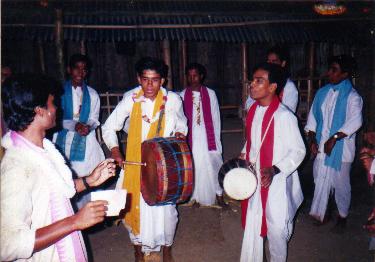
|
Also
different manifestations
of the song, dance, and martial arts culture that is intrinsic to Manipuri
people -
Udukhol: Krishna's Valya
Lila and Vatsalya Ras is enacted through this dance and
devotional music.
Basak:
Basak is
kind of Sangkirtan for males and females alike. The theme is derived from Basak
Sajya, preparation of a seat for Sri Krishana and Sri Radhika and her
maids with flowers.
Gouralila: Performed by
boys of the age group of 8 and 10 years, representing Sri Chaitanya's lila
such as meeting the Kesav Vharati, saving jogai - madhai,Touching scenes
of Vishnupriya Separation etc.
Thang
Ta: Martial arts
by the Manipuri Meitheis, the dance with the use of spear and sword.
Sword constitudes the body and the spear, the soul, so goes the saying of
the Meitheis.
Nupi
Pala: A kind of
Kirtan performd by female in sitting position with mandira's (small
cymbals) in hand.
Dhop
Kirtan: A kind of
kirtan style which is devoid of movements, must be held in connection of
Durga Puja, Jhulan Jatra, Mera and Kartika festival.
Ipom: A form of
entertainment where two or three Jtra personalities take part and discuss
something. Sumanglila is the most popular form.

Tribal
Dances Of Manipur
The Dance
patterns in Manipur Must have a link with Gandharva's Culture - which
is mythological believed to excel over all other dance forms. There shall
be no reason against the fact that the elements of the subdued, slow, rhythmic
movements present almost in all the tribal dances. Ethnically, the
hill tribes of Manipur though divided into a number of clans and sections,
may be grouped into two main divisions - Naga and Kuki
.These people have their distinctive Languages and cultural heritages of
their own. The dances are also artistic. The noted tribal dance in Manipur
are Tangkhul Naga Dance, Mao Dance, Mizo Bamboo Dance, Tarao War Dance,
Kabui War Dance, Tangkhul Naga Hunting Dance, Surung Dance and Rengmai
Naga Dance etc.
Contribution Of Rabindranath Tagore
Rabindranath Tagore ,the world poet was fascinated with
the lovely and charming Manipuri Rosella at Machhimpur,
a Bishnupriya Manipuri locality in the modern Sylhet District in
Bangladesh in 1920....
Rabindranath
Tagore, the world poet, was a great patron of the Manipuri dance and
culture. He also deserves a honorable place in the style and regarded as
the " pioneer of Manipuri dance and culture". It was he who
popularized the style with its high zenith among the people of the world.
The world poet was fascinated with the lovely and charming Manipuri Rasleela
at Machhimpur, a Bishnupriya Manipuri locality in the
modern Sylhet District in Bangladesh in 1920. He immediately decided to
open a new department of Manipuri Dance in his Shantiniketon in Calcutta.[Note
8] Consequently , he invited Guru Senarik Singha
Rajkumar, - a native
of kalijar downtown Silchar of Assam and Guru Nileshwar Mukharjee of
kamlganj thana of undivided Sylhet district. Both of the Gurus belonged to
the Bishnupriya Manipuri Community, [Note 9] and with
them the new department of It was an epoch making events in the history of
Manipuri Dance and within a decade in crossed its regional as well
national fields and became a reputed international style.
Famous
Manipuri Artists
Guru Nileshwar
Mukharjee from Bangladesh and Guru Senarik Rajkumar from India are well
known to Manipuri society as with them the new department of Manipuri
Dance was created in the Shantiniketon in the early thirties. The present
noted Manipuri dancers of India and Bangladesh, as well as international
fame are Hanjaba Guru Bipin Singha, Guru Chandrakanta Singha -
Nartanachrya, Guru Nilmadhab Mukharjee, Guru Haricharan singha, Bibhaboti
Devi, Kalabati Devi etc. Most of them have their dancing tours on the
manipuri to England, America, Russia, Australia, Japan, Germany, Italy,
France, Honking, Thailand, Bhutan, Sri Lanka etc. and earned great name
and fame for their style. Among Non-Manipuri dancers, the names of Preeti
patel, Sruuti Banerjee, Tamanna Rahman ( Bangladesh) and Jhaveri sisters
can be included. Among the above mentioned dancers, Guru Bipin Singha ranks
top. He may rightly called the " Father of Manipuri Dance and
style". He was awarded with a number of the prestigious titles like Bharat
Ratna,kalidas etc. Guru Bipin Singha, the Kalidas, has the past
four decades with his disciplines - the Javery sisters -has contributed a
great deal in the field of Manipuri dance and culture. In
Bombay the famous performers and teachers are the Jhaveri sisters -
Nayana,Suverna, Darshana and Ranjana Jahveri. They continue this tradition
at their institution 'Manipuri Nartanalaya'. These artists have spread the
beauty of Manipuri dance all over the world and have been honored both
nationally and internationally on this subject.

References:
1.
The Gandharva's dance
skills are mentioned in the Ramayana and Mahabharatas and
other Hindu Puranas. However, Scholars have different opinions as
well as views regarding the exact location of the Mahabharatya Manipur with the recent Manipur. In
the Allahabad stone pillar inscription of Samudra Gupta(4th century
AD) there is no mention of Manipur, although the neighboring kingdoms are
named. According to the Mahabharata, the ancient name of this country was
‘Meckley’ and this is the name that was used when King Gaursham signed
a treaty with the British in 1763.
In 1876, the king of Manipur used the same name referred to his kingdom
which is documented in the treaty with the British Government. In old
assamese records, Manipur is mentioned as Magloo or Moglai.
The Burmese call the country a Cassey or Kassay. McCulloch
describes that," the name Manipur accounted for by the Munniporie,
who quote the Mahabharata in confirmation of its accuracy. They gave the
same from Muni, a jewel ". On the other hand G. E.Geraini, in his
work, Researches on ptolemy's Geography, States that "
Bishnupur was the ancient capital of Manipur and Imphal locally known
as kangla or kangleipak was the capital of the Meitei Leipak of the later
period which finds mentioned in the Meitei purana, i.e. Bijoy panchalee."
So, Imphal come into existence in much later period than that of the city
of Bishnupur as stated by Prof. Padmanath Battacharjee. Dr. Dinesh
Chandra Sen( Brihod Bongo, 1935), Shri Ochchutcharan Chaudhury Tatvanidhi
( Srihotter Itibritta, 1905, ), Shri Janokinath Bosak( Manipur prohelika),
L. Ibubghal Singha ( Manipura), Sri Sena Singha ( Prachinadhunik somkhipta
Manipurer Itihas), Shri Mukundalal Chowdhury ( Manipurer Itihas), Shri
Mohendra Kumar singha ( Manopurer Prachin Itihas), Shri Krishnamohon Dhar
(Purbabango O Assam, 1909) and some other Indian scholars and
historians idientified the present Manipur to be that of the epic as
described in the Mahabharata, in their writings and articles. [
Back ]
2.
Most orthodox Manipuris
believe that, the names of the state / Capital and the people,
Bishnupur and Bishnupriya undoubtedly come from the noteworthy tribe of
group of people whose nucleus was in Vrishni where from their ancestors came
and enter Manipur, in olden times. The descendants of and followers of the
afore-said five heads of sects of Vrishni declared themselves as the Pancha
Bishnupriya ( Bishnupriya : corruption or derivation from the
word Vrishni) Manipuris. The evidance is also found in distinctly in this
regard from a thorough study of Bishnupriya Manipuri language which is in
close proximity with the Sauraseni-Maharastri Parakrit and also contains
pure Vedic or Sanskrit words. [
Back ]
3.
The inhabitants of Manipur did identify them as "Manipuris" since past centuries.
The land Manipur was formerly divided into small territories occupied by different clans,
namely, the Khumals, the Moirangs, The Angoms, The Luwangs, the Ningthoujas, etc.
The territories were after the names of the respective clans.
Besides there are 70 Lokei( Ningthou –Khongya or members of Royel Family), Lempa Lokei
(Thakcham),
Moirango Lokei (Moirang –them) are the dominating groups. Each of the Lokei have their
distinct ethnic identity( Gotros). So different clans of the Aryan and Mongoloid people
lived side by side in Manipur for centuries. Conversion of Meiteis in Hinduism by Shri
Santidas Babaji in 19th century at the instance of the king Shri Pamhaiba was aimed at
linking the with the Aryans, the mainstream of people of Manipur and their language too
with Sanskrit.The Aryans, the followers of Lord Vishnu denied to accept the initiation by
Shri Santadas Babaji and the others(accepted). And thus the Manipuri people – Aryan and
Kuki-chin group have been classified and renamed as Bishnupriya and Meiteis their language too.
Culturally, the Meiteis and Bishnupriyas cannot be distinguished from each other. Both these
two clans developed a homogeneous culture, and the concept of the one community grew among
them. [
Back ]
4.
Manipur-or Meckley -is actually on a tableland surrounded by hills. In
the plains beside the loktak lake
lived a race of people who had sharp Indo-Aryan features and used a
language which was similar to the Kamrupi tongue rather than the
Burmese-Chinese group. For centuries these Aryan people have been called
‘Khalachai’ which in southern Chinese dialect means ‘Children
of the wide lake’ (Kha=Lake; La=Wide; Chai=Children) as described by
Shri R. M. Nath in "The Background of Assamese Culture" ,
Page 86-87, 2nd Edn,1978. [
Back ]
5.
Statement by Late L
Iboonghal singha, Rtd. District and sessions Judge of Manipur in a monthly
Magazine "Ritu", 1959, page -21 : " Arther Paliot
in his History of China stated that the chinese invaded Manipur in about
700 A.D. and won over the war. They called Manipuris as khalachais or sons
of the wide lake ( Loktak) and described them as highly civilized".
The Chinese inroads over the valley was authenticated in the writing s of
Hien-Tasng, the great Chinese traveler who has visited the court of Kumar
Vaskar Varma of Kamrupa in the 7th Century A.D.( Ref .from Cultural
Heritage of North-Eastern India / Bidhan Singha, Assam , 1999). [
Back ]
6.
Excerpts from the article A
people Besieged by Syed Jainul Akmal Al Mahmood / The daily star
Weekend Megazine, Vol-4, Issue-184, Jun 21,2000 Dhaka, Bangladesh,
Page -7. Also includes these lines - " To this days, popular
memory of love affair between Khamba and Thoibi. Who knows, if the affair
hadn't ended in tragedy, the course of history might have been altered; perhaps
the Bishnupriyas wouldn't have in exile today." [
Back ]
7.
W. Yamjao Singh, in his
book "An early history of Manipur" says that -"Thus
from the earliest time Manipur was a Brahminical kindom and was learned
well enough, their fame in astrology reaches as far as the distant part
china"(page -23). So, references of ancient Manipur are not of
the non-Aryan people. The Manipuri community is divided into the following
clans such as Khumal, Moirang, Angom, Luwang and Meithei etc.( Ref: Assam
District Gazette/ V.C Elen, Religious Development in Manipur in
18th and 19th Century/ Dr. M. Kirti Singha, Descriptive Ethnology
of Bengal/ E. T. Dalton), out of which the first four clans are other
than the Meithei and belong to Aryan. The Khumals were most powerful and
after them The Moirangs whom subdued by the Meitheis and form them into a
single people (Ref: Assam District Gazette/ V.C Elen, Part -IX,
Chapter -II, Page-11). [
Back ]
8.
References from "Sribhumi
Sylhete Rabindranath" ( A Bengali Booklet ) / NripendraLal
Das, 1990, Bangladesh and Manipuri Rasalila Swaranika /MRUC, 1992).
[
Back ]
9.
Reference from The
Action, Guahati, India, May 15, 1990 Issue. [
Back ]
10.
Page 186-187; Religion and
culture in Manipur by Dr. M. Kirti singha,M'A. LLB, Ph.D.
[
Back ]